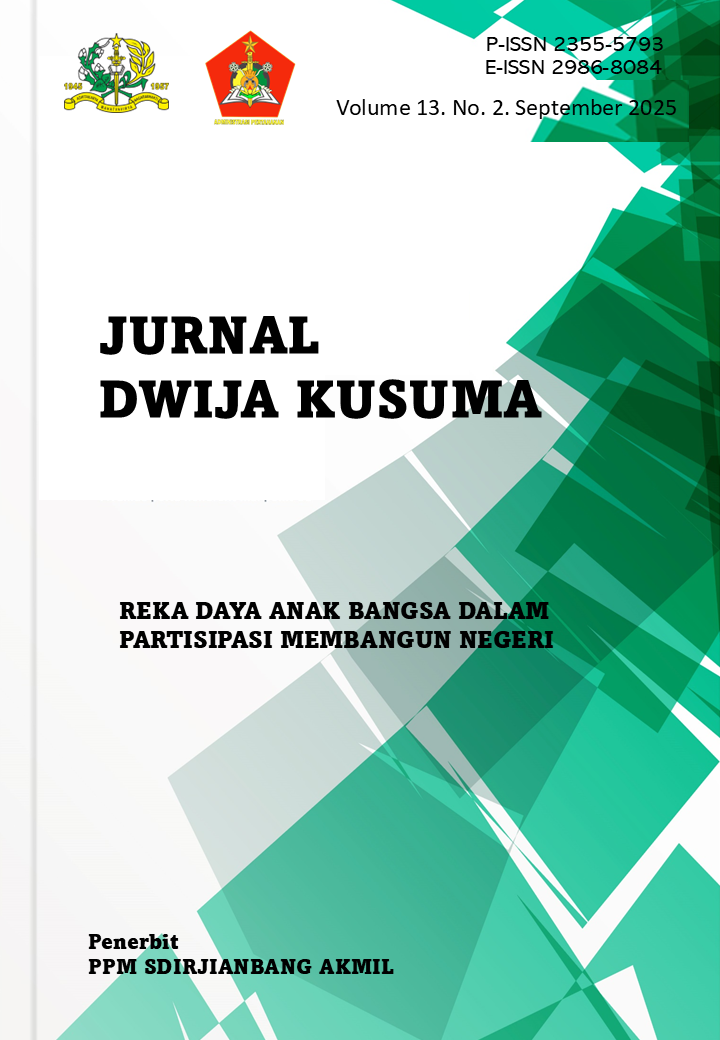MODEL MANAJEMEN RISIKO DALAM ADMINISTRASI PERTAHANAN
Kajian Literatur Sistematis Terhadap Ancaman Hibrida Dan Non-Militer
DOI:
https://doi.org/10.63824/jdk.v13i2.373Keywords:
Defense administration, Risk management, Hybrid threats, Non-military threats, National resilienceAbstract
Defense administration faces complex challenges from hybrid and non-military threats that undermine national defense effectiveness. This study aims to formulate an adaptive risk management model through a systematic literature review of 35 academic articles, policy reports, and international standards. Data were analyzed using content analysis and thematic coding, adopting the ISO 31000:2018 framework and NATO AJP-3.15 doctrine. The findings highlight five key stages of risk management—identification, analysis, evaluation, mitigation, and monitoring—enriched with whole-of-government and whole-of-society principles. The novelty of this research lies in synthesizing international frameworks with Indonesia’s local context, producing a conceptual model of defense administration that is systematic, participatory, and responsive. These findings imply significant contributions for the Ministry of Defense and the Armed Forces in strengthening national defense resilience against multidimensional threats.
References
Aditya, R., & Kusuma, D. (2022). Administrasi pertahanan Indonesia di era disrupsi: Tantangan dan peluang. Jurnal Pertahanan dan Bela Negara, 12(2), 145–162. https://doi.org/10.22146/jpbn.2022
Bachmann, S. D., & Gunneriusson, H. (2022). Hybrid wars in the 21st century: New threats, new approaches. Defence Studies, 22(1), 1–19. https://doi.org/10.1080/14702436.2022.2034159
Badan Nasional Penanggulangan Bencana. (2023). Laporan tahunan bencana Indonesia 2023. BNPB. https://bnpb.go.id
Badan Siber dan Sandi Negara. (2022). Laporan tahunan keamanan siber Indonesia 2022. BSSN. https://bssn.go.id
Chivvis, C. S. (2021). Understanding Russian “hybrid warfare” and what can be done about it. RAND Corporation. https://www.rand.org/pubs/perspectives/PE301.html
International Organization for Standardization. (2018). ISO 31000:2018 Risk management — Guidelines. ISO. https://www.iso.org/standard/65694.html
Kitchenham, B., & Charters, S. (2007). Guidelines for performing systematic literature reviews in software engineering. Keele University.
Mumford, A. (2020). Strategy in the contemporary world: Hybrid threats and strategic adaptation. Oxford University Press.
NATO Standardization Office. (2020). AJP-3.15 Allied joint doctrine for countering hybrid threats. NATO. https://nso.nato.int/nso/nsdd/listpromulg.html
Page, M. J., McKenzie, J. E., Bossuyt, P. M., Boutron, I., Hoffmann, T. C., Mulrow, C. D., ... & Moher, D. (2021). The PRISMA 2020 statement: An updated guideline for reporting systematic reviews. BMJ, 372, n71. https://doi.org/10.1136/bmj.n71
RAND Corporation. (2023). Countering disinformation and hybrid threats: NATO’s evolving strategies. RAND. https://www.rand.org/pubs/research_reports/RRA1234-1.html
Republik Indonesia. (2002). Undang-Undang Nomor 3 Tahun 2002 tentang Pertahanan Negara. Lembaran Negara Republik Indonesia.
Republik Indonesia. (2021). Peraturan Presiden Nomor 8 Tahun 2021 tentang Kebijakan Umum Pertahanan Negara. Sekretariat Negara Republik Indonesia.
Snyder, J. (2021). Non-military threats in the age of globalization: Climate, pandemics, and resilience. Journal of Strategic Security, 14(3), 25–40. https://doi.org/10.5038/1944-0472.14.3.1889
Suryadinata, L. (2020). Indonesia’s defense administration during the COVID-19 pandemic: Challenges and adaptations. Contemporary Southeast Asia, 42(2), 219–240. https://doi.org/10.1355/cs42-2e
Downloads
Published
How to Cite
Issue
Section
License
Copyright (c) 2025 Khairul Muslim, Ahmad Taufik

This work is licensed under a Creative Commons Attribution 4.0 International License.











